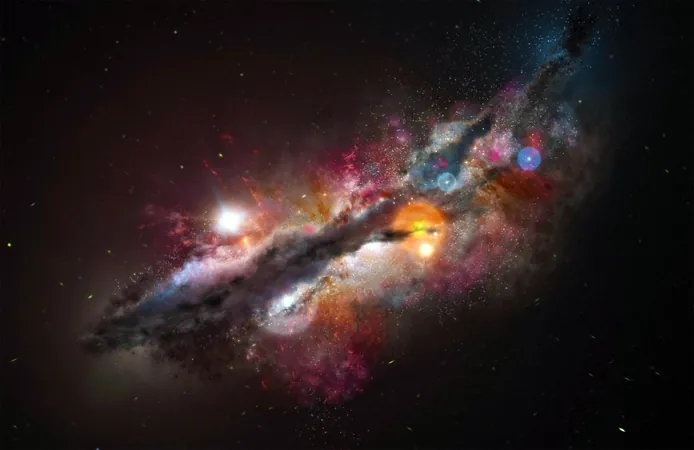
Revolutionary Discovery: Oxygen Found in Ancient Galaxy Challenges Our Understanding of the Universe
2025-03-21
Author: Ying
A Cosmological Time Capsule
JADES-GS-z14-0 resides approximately 13.4 billion light-years away, meaning that its light has been traveling to us for about 13.4 billion years. Thus, we see this galaxy as it appeared when the Universe was merely 300 million years old, representing a mere 2% of its current age. Astonishingly, despite its youth, the galaxy exhibits signs of complex development that challenge previously held assumptions.
The European Southern Observatory (ESO) and ALMA have played vital roles in this groundbreaking discovery, revealing cosmic details previously beyond reach. As Sander Schouws, a PhD candidate from Leiden Observatory, aptly described it, “It is like finding an adolescent where you would only expect babies.”
Mature Galaxy in an Infant Universe
Traditionally, early galaxies were expected to consist chiefly of hydrogen and helium, with heavier elements such as oxygen emerging only later through the cycles of star life and death. Oxygen forms within the cores of stars before being dispersed into space through supernova explosions. Until now, many astronomers believed that not much of this process had occurred within the 300 million-year window post-Big Bang.
However, JADES-GS-z14-0 exhibits a surprising abundance of heavy elements, approximately ten times more than previously anticipated for such an early galaxy. This suggests a much more rapid cycle of star formation and death than earlier models proposed.
Stefano Carniani from the Scuola Normale Superiore in Pisa, Italy, expressed his astonishment: “The evidence that a galaxy is already mature in the infant Universe raises profound questions about how galaxies formed and evolved.”
Precision in Cosmic Measurements
The detection of oxygen has offered astronomers a new method for measuring the galaxy’s distance with remarkable precision. Eleonora Parlanti, a PhD student at the Scuola Normale Superiore, highlighted the significance of this finding, noting that ALMA's detection allows for distance estimation with an uncertainty as low as 0.005%, likening it to being accurate within just 5 centimeters over a kilometer.
A Synergistic Approach to Understanding Cosmic History
While ALMA delivered crucial confirmation, the tale of JADES-GS-z14-0 starts with the James Webb Space Telescope (JWST), which initially detected the galaxy and deemed it worthy of further investigation. The collaboration between ALMA and JWST exemplifies how combined observational power can unveil the early formation and evolution of galaxies by analyzing both their light and chemical signatures.
A Paradigm Shift in Galaxy Evolution
Finding oxygen in such a young galaxy suggests that the early Universe may have developed much more swiftly than prior models suggested. It raises significant questions about when and how galaxies designed complex structures and attained oxygen-rich chemical diversity.
Gergö Popping, an ESO astronomer, expressed his surprise at the discovery, noting its implications for our understanding of galaxy formation in the wake of the Big Bang. “This result showcases the paramount role ALMA plays in revealing the conditions under which the first galaxies in our Universe were formed,” he said.
New Questions Arise
This remarkable find leaves astronomers grappling with numerous questions. How did such a nascent galaxy attain chemical maturity so swiftly? Are there other galaxies akin to JADES-GS-z14-0 waiting to be discovered? If so, what implications do they bear for our current theories on galaxy formation?
As both ALMA and JWST continue their explorative endeavors, scientists are optimistic about uncovering more ancient galaxies, thereby gathering compelling evidence that will frame our understanding of the Universe's formative periods. The early cosmos might be far more vibrant and dynamic than we ever envisioned.
Stay tuned for more exhilarating updates on astronomical breakthroughs that are reshaping our understanding of the Universe!



 Brasil (PT)
Brasil (PT)
 Canada (EN)
Canada (EN)
 Chile (ES)
Chile (ES)
 Česko (CS)
Česko (CS)
 대한민국 (KO)
대한민국 (KO)
 España (ES)
España (ES)
 France (FR)
France (FR)
 Hong Kong (EN)
Hong Kong (EN)
 Italia (IT)
Italia (IT)
 日本 (JA)
日本 (JA)
 Magyarország (HU)
Magyarország (HU)
 Norge (NO)
Norge (NO)
 Polska (PL)
Polska (PL)
 Schweiz (DE)
Schweiz (DE)
 Singapore (EN)
Singapore (EN)
 Sverige (SV)
Sverige (SV)
 Suomi (FI)
Suomi (FI)
 Türkiye (TR)
Türkiye (TR)
 الإمارات العربية المتحدة (AR)
الإمارات العربية المتحدة (AR)